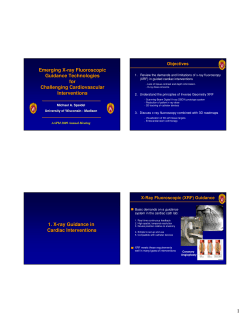
Resolution of Recurrent GI Bleed Following Alcohol Septal Ablation for
Resolution of Recurrent GI Bleed Following Alcohol Septal Ablation for Hypertrophic Obstructive Cardiomyopathy Oral A. Waldo, MD, Pragnesh P. Parikh, MD, Joseph L. Blackshear, MD. March 2nd 2013 American College of Physicians PGY-2 Internal Medicine ©2012 MFMER | slide-1 Learning Objecti Objective e • To understand the recognition, diagnosis, and management of acquired von Willebrand syndrome (AVWS) in the g of Hypertrophic yp p Obstructive setting Cardiomyopathy (HOCM) ©2012 MFMER | slide-2 Hi t History off presentt Ill Illness • A 71 year old female chief complaint of recurrent melena • Transfusion dependent GI bleed for 4 years baseline hemoglobin 7 mg/dl • Multiple endoscopies/deep enteroscopies: • Small bowel arteriovenous malformations (AVM) • Ablation of four AVMs in the jejunum. • She ultimately underwent resection of the ileocolonic region, but continued to require frequent transfusions as often as every 2 to 3 weeks. • Review of Systems: • Dyspnea on exertion, chest discomfort. Few presyncopal episodes, y p but no syncope. ©2012 MFMER | slide-3 • Past Medical History • Mitral regurgitation • Exploratory laparotomy with partial small bowel resection • Hysterectomy • Repair of left hip fracture • Social History • Does not Drink. Smoke 3 cigarettes daily • Family History • She had 5 siblings • 1 sister who died suddenly in her 40s unknown cause. • 5 sons and 1 daughter, no history of heart disease ©2012 MFMER | slide-4 Ph i l E Physical Exam • • • • • • • • VS: Afebrile BP= 140/72 P=82 RR =18 General: feeble female female, poor functional status HEENT: No oral mucosal bleeding Cardiovascular: • S1S2,, RRR,, Bifid carotid pulse p and bifid apical p beat. • Harsh, 3/6 systolic murmur at left parasternal edge which decreased with hand grip. • Occasional extrasystoles, with an increase in the murmur to grade 4 following the extrasystole Chest: Clear to auscultation Abdomen: Soft with mild epigastric tenderness Extremity: Without edema I t Integument: t No N bruising b i i or suspicious i i llesions i ©2012 MFMER | slide-5 L b t Laboratory fifindings di • Hb= 7.3, Plt = 129 • BMP normal • PT/PTT normal ©2012 MFMER | slide-6 Echocardiogram Showing HCM ©2012 MFMER | slide-7 Peak velocity = 4m/s, Peak gradient = 64mm Hg “Severe Obstruction” ©2012 MFMER | slide-8 F th Laboratory Further L b t A Analysis l i • Platelet Functional Assayy ((PFA)) • Collagen EPI >300 (50- 175) • Collagen g ADP = 182 ((57-121)) • VW ag = 165% • VW activity = 98% • Ratio, Act/Ag =0.59 (normal > 0.8) =AVWD • VWF multimeric analysis: Loss of highest molecular weight multimers ©2012 MFMER | slide-9 Von Willebrand Disease Background • Most common inherited bleeding disorder ~1% of the population • Made by Endothelial cells and megakaryocytes • Carries factor VIII • High molecular weight multimers (HMWM) are the most active forms • Can C be qualitative vs quantitative defects • Leo et al. Haleo Orthopedics 2008 ©2012 MFMER | slide-10 V Willebrand Von Will b d Disease, Di Bleeding Bl di • Trauma/wounds/surgery, g y, p post-partum, p , menorrhagia, g , epistaxis/gingival, GI • Often exacerbated by aspirin • Inherited types: • Type I, partial Quantitative deficiency • Type 2, qualitative abnormalities • Type 3, severe, undetectable levels of VWF • Acquired von Willebrand syndrome: • Cardiac disorders with turbulent flow, ie aortic stenosis, ste os s, hypertrophic ype t op c ca cardiomyopathy, d o yopat y, ventricular assist devices • Hematologic disorders, ie monocolonal gammopathy • Drugs, D h hypothyroidism th idi ©2012 MFMER | slide-11 AVWS in Aortic Stenosis VWF multimers and Model of Pathophysiology Blackshear et al Blackshear, al., 2012 Sadler NEJM Sadler, NEJM, 2003 Casonato, et al., Thrombo and Haemo, 2011: Evidence against proteolysis by ADAMTS13 in all cases. Decrease in HMWM more p pronounced with rheumatic than degenerative, dystrophic AV disease. ©2012 MFMER | slide-12 AVWS testing and treatment Coordination with Reference Laboratory is Critical • Many VWF tests associate with severity of AS • PFA-100 PFA 100 – sensitive • VWF collagen binding assays -sensitive • VWF multimer analysis - sensitive • Ristocen Cofactor activity – insensitive MULTIMERIC ANALYSIS Patient Control HMWM LMWM ©2012 MFMER | slide-13 E l ti off th Evolution the Case C • Multiple p comorbidities, p poor surgical g candidate. • Alcohol septal ablation was performed to two septal branches of the left anterior d descending di coronary artery. t • Alcohol Septal Ablation is a performed in the cardiac di catheterization th t i ti lab l b • Echo contrast injected to show target area for infarction: creates localized damage with thinning of septum, and reduced gradient • Alcohol injected slowly to damage muscle ©2012 MFMER | slide-14 Al h l S Alcohol Septal t l Abl Ablation ti Echo contrast injected Position of microcatheter Showing Septal perforator ©2012 MFMER | slide-15 Four Months After Septal Ablation ©2012 MFMER | slide-16 Follow-up • Six months following the procedure • Did not required a transfusion • VWF multimers normalized • Baseline hemoglobin now 14 mg/dL (the highest in four years), • Left ventricular outflow tract g gradient reduced from 64 mm Hg g previously to 14 mm Hg. Peak velocity 1.8 m/s Peak gradient 14 mm Hg ©2012 MFMER | slide-17 Summary • Consider VWS in p patients with recurrent GI Bleed and cardiac murmurs. • Coordinate with laboratoryy directoryy to assist with lab orders of VWS • Correction of the cardiac abnormalityy resolves bleeding in 80% of cases ©2012 MFMER | slide-18
© Copyright 2025





















